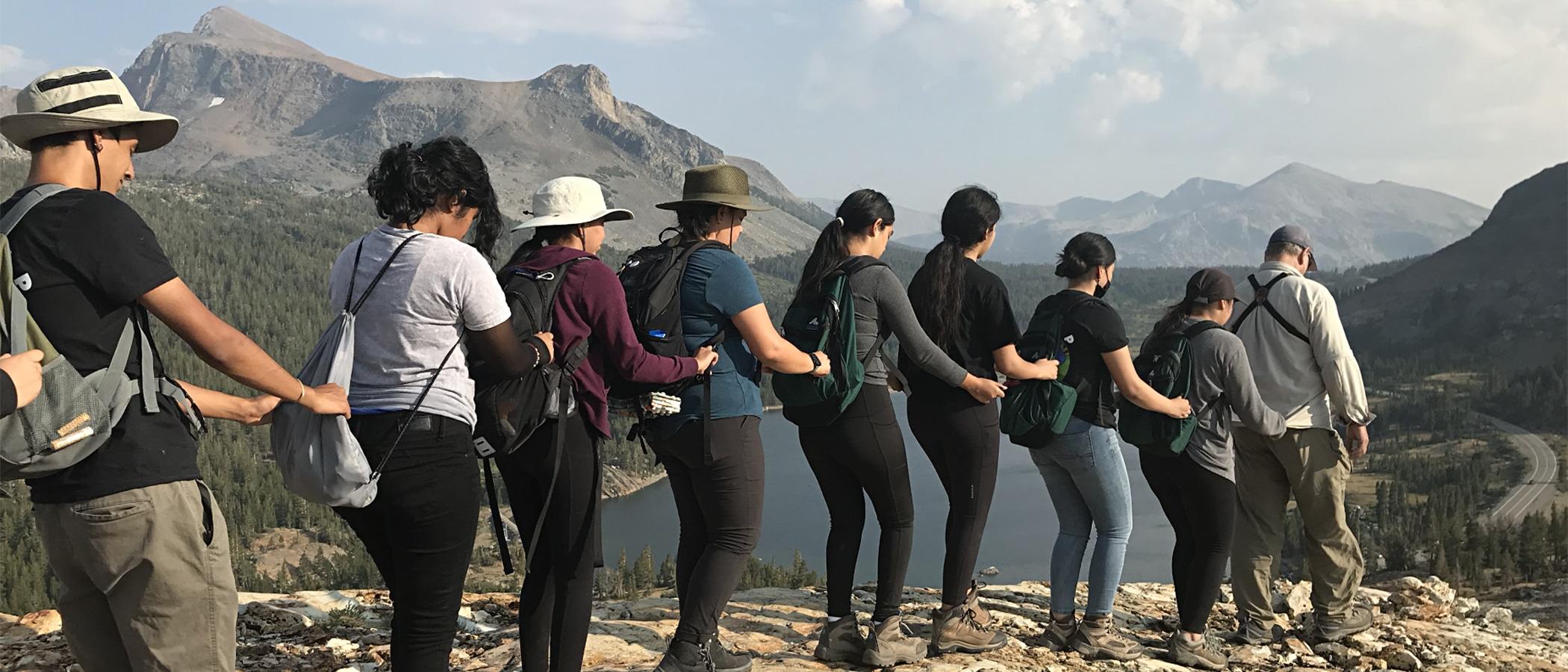
This article, written by Caelen McQuilkin, was originally published in the Mammoth Times and is posted here with permission. Content warning: It contains content about the displacement of Indigenous people and violence towards communities of color, including police brutality. This article was written on, and inspired by, the Mono Lake Kootzaduka’a Tribe’s traditional homelands and waters.
Los Angeles-based activists share their thoughts on racial justice in the context of the Mono Basin-Los Angeles watershed
Carried by the Los Angeles Aqueduct, water diverted from snowmelt in the Sierra above Mono Lake flows 338 miles south to the city of Los Angeles, creating an inextricable link between the place the water comes from, and the place it flows to. The water that forges this unlikely connection also shapes the people who live off it, facilitating an exchange of ideas between Mono Lake and Los Angeles.
The Mono Basin Outdoor Education Center (OEC) embodies this connection. Founded in 1994 in partnership between the Mono Lake Committee, the Mothers of East Los Angeles Santa Isabel, and other Los Angeles-based community groups, its mission is to “build understanding and appreciation for the Mono Basin-Los Angeles watershed.” The OEC brings Los Angeles students and community groups, primarily from historically marginalized communities, to the Eastern Sierra to educate them about the place their water comes from. It empowers them to return to their communities with a deeper understanding of the links between water and power injustices—and resistance—from rural California to the inner city.
Like so much in California, the story of the OEC begins with water. The Sierra Nevada forms what Santiago Escruceria, the Outdoor Education Center Manager, calls “the backbone of California,” as “most of the snow that eventually turns into water, that is used by most of California, falls there.” Without water, there is no life, he says. “No water, no agriculture. No water, no wildlife. No water, no forests. We would not be the state that we are now, if it wasn’t for that resource called water that falls on those mountains up there, on that mountain range.” When students and organizations from Los Angeles, many of whom shower and cook with that very same water at home, come spend a week hiking up and down the “backbone” from which it originates, Escruceria and other OEC program leaders have the perfect opportunity to educate and empower.
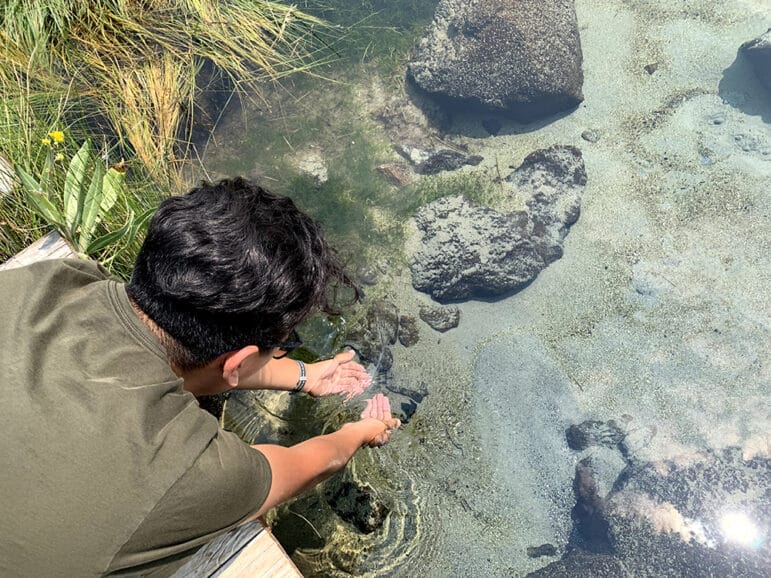
Part of the OEC’s legacy lies in its ability to help groups begin understanding the inherent connection between the Eastern Sierra and the place they come from. This summer, I had the privilege of speaking to OEC participants from two groups who came to the center: East Yard Communities for Environmental Justice (EYCEJ), an environmental health and justice non-profit that is “working towards a safe and healthy environment for communities that are disproportionately suffering the negative impacts of industrial pollution,” and Pacoima Beautiful, an environmental health and justice non-profit with the mission of “empowering community members through programs that provide environmental education, advocacy, and local leadership in order to foster a healthy and safe environment.”
Over the course of their time at the OEC, members of these groups began to see water as a medium for understanding environmental justice as a linking factor between their communities, and Eastern Sierra communities. The Mono Basin-Los Angeles watershed links together two seemingly opposite locations, some told me, by connecting at least one part of the environmental issues they experience, and the people who bear the burden of those issues. In addition, group members believed, conversation among the people of that watershed provides something like hope for a cleaner and more just future.
These conversations, ultimately, provide insight into the stake we hold in one another’s well-being, both environmentally and socially. To learn more about the understanding of connection, and the tools we need to build coalitions fighting for an equitable future, read on.
~~~~~~~~~~~
From the moment the OEC participants’ cars reach the Mono Basin, they are thrown into an environment unlike anything that most have experienced before. Program leaders encourage participants to lean into and embrace this difference, which they say often leads to the most memorable experiences and realizations to bring home. “I need you to take a feel for this place,” Escruceria told the EYCEJ group on its first full day. “That is how you are going to get the most out of being here. What changes, what sounds, what smells? What are you feeling in your heart?”
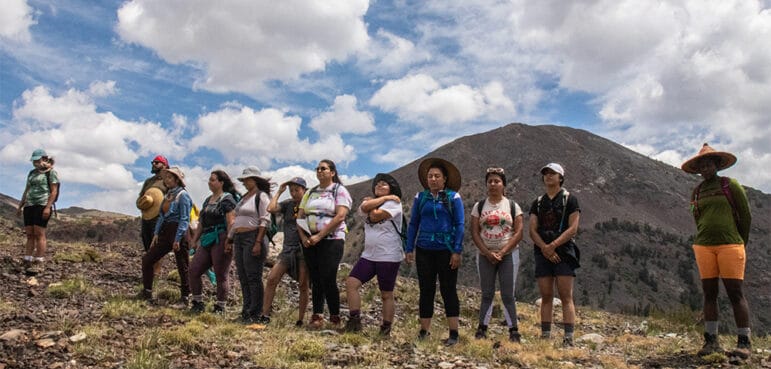
For many, one of the biggest of those changes and feelings is the nighttime sky. Marlene Ceja, a rising junior at San Fernando High School and member of Pacoima Beautiful, recounted: “In Los Angeles, we don’t ever see stars. If we’re lucky enough, we can see five, and they’re really tiny. I’m talking about my home,” she said. “When I look up, I can barely see anything. And when I got here, I would see shooting stars. I think that was the thing that stood out to me most.” Vianey Moreno, a youth leader at Pacoima Beautiful, similarly reflected: “For a lot of the kids, it’s their first time seeing the sky be so bright, with so many stars at once. Some have gone camping, but for the majority, nobody has ever taught them so deeply about things like what constellations are in the sky.”
Other program participants noticed the difference in sound right away. “It’s so noisy in LA, right? [You] can hear dogs barking, the freeway, helicopters. There’s so many sounds,” said Tiff Sanchez, a youth organizer at EYCEJ who came to the OEC with a group of coworkers from her organization. “And then when you get here [to the Eastern Sierra] it’s just quiet. And it’s so loud. The quietness is so loud.”
With experiences so far outside their norm, group members often find themselves pushed outside of their comfort zone. America Gonzalez, a rising senior at Sun Valley Magnet School and member of Pacoima Beautiful, remembered how she felt on the first night when her group went on a solo night walk. “The first day we came, Santiago put us to walk alone by the creek in the dark. So many fears came to me. I was like ‘this is so scary.’ At first I didn’t like it,” she said. “But at the same time, I was like, ‘okay, it’s fine. I’m going to be okay.’” After she finished the walk, Gonzalez said, she had started to love it. “I felt awesome. It was awesome,” she said.
Group members testified that getting to see nature and push one’s comfort zone in this way is especially significant coming from communities with very limited access to outdoor spaces or even green spaces within their city. “We don’t have access,” explained David Diaz, a youth organizer with Pacoima Beautiful. “It’s city city city. That feeling of belonging, like you belong in the natural spaces, we didn’t have that growing up. I know it’s really hard to feel that belonging when you don’t have a lot of access to outdoor spaces, so I’m really happy that we can take [our students] here,” he said. Gonzalez had similar thoughts. “There are places you can hike [in Los Angeles]. But you only see it in the nicer areas, you don’t see it in your own neighborhood. [Being outdoors] is not a priority, for sure. It’s more like a privilege,” she said.
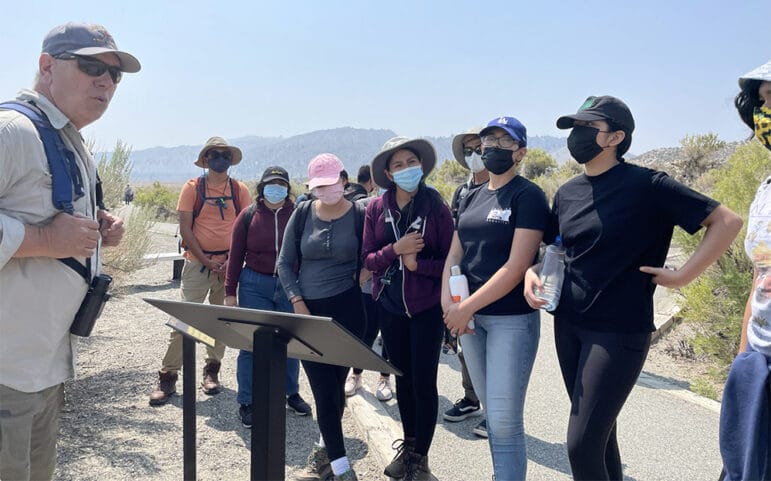
Being in the outdoors in the Mono Basin, then, is empowering both for the sake of simply getting to be there, and for the knowledge and experiences that group members are able to take home and use to support their struggles for justice in their neighborhoods. “We are part of what folks call frontline communities, Black, Indigenous communities of color that are burdened with disproportionate costs of pollution,” said Paola Dela Cruz-Perez, a youth organizer at EYCEJ. “That means all kinds of pollution, specifically air pollution. We have warehouses, we have refineries … ports, railyards, diesel trucks. All of it.” Sanchez illustrated what that frontline community looks like when she was assigned to draw her neighborhood during one of EYCEJ’s programs. “I have the bridge, this really busy bridge right across my street,” she explained, showing the drawing. “We get these really beautiful sunsets, but that’s because of the air pollution. There’s a large police presence. There are houseless folks living on the streets, and street vendors. I didn’t draw any faces on them, because for whatever reason, society doesn’t deem them as a part of it. Those are our communities.” Ceja spoke on this reality of her life growing up as well. “My community is very polluted, and we don’t have the best resources,” she said. “We’re looked down upon because we are low-income communities.”
For this reason, group participants explained, they have been forced to realize the importance of slowing climate change and advocating for safe environmental practices, because the repercussions can sometimes be the literal difference between life or death. That’s the reason why these OEC participants joined the environmental justice groups they did, and the reason those groups have achieved many successes in keeping their communities safer from pollution and other negative environmental impacts since their founding.
However, the work is difficult, and the odds—and the structure of our society—are stacked against these groups. For example, Ceja said, “in Pacoima, there was a methane leak, and we didn’t even know about it. We were trying to shut down the gas plant, because they were trying to keep it a secret, instead of just fixing it. The leak was there for two years, and nobody had a clue.” Joining Pacoima Beautiful, she explained, inspired her to begin recognizing and fighting against these injustices. “Honestly, I didn’t even realize [what the gas plant was.] I knew that it was there, but I didn’t know what it was until I came to Pacoima Beautiful. I would never have even questioned it. That’s how used to [these injustices] we are,” she said. “I wish things like this could surprise me. I would want an injustice like that to surprise my community. But it doesn’t, because it’s Pacoima, so what do you expect, you know?”
The unequal distribution of air-polluting factories, gas plants like the one in Pacoima, large freeways, and other industry is no coincidence. “Environmental racism is very clear in our lives,” said Dela Cruz. “That’s because of who we are, the color of our skin, and our ethnic, racial and class background.” These systems of oppression have existed since the colonization of the United States, she explained, under which degradation of the environment, and other harm, always causes a disproportionate impact on the people pushed out and altered by that colonization.
This deep and personal understanding of systems of oppression in the city, when paired with knowledge about the history of the water that flows to Los Angeles, becomes powerful. “The process is pretty sweet, as I take them to the lake and start to give them the political, natural, and cultural history of the area,” explained Escruceria. “They start to get a better understanding of the position that this area has in connection with the area that they live in. They start to open their eyes and reckon with the idea that everything is interconnected. That them being 350 miles away, and what they do down there, has a repercussion of what happens here.” The environmental threats that most heavily impact marginalized groups are clearly different in Los Angeles than they are in the Eastern Sierra, he said, but the unique issues that each area faces are heavily influenced by one another. In other words, both places hold a stake in the other’s well-being.
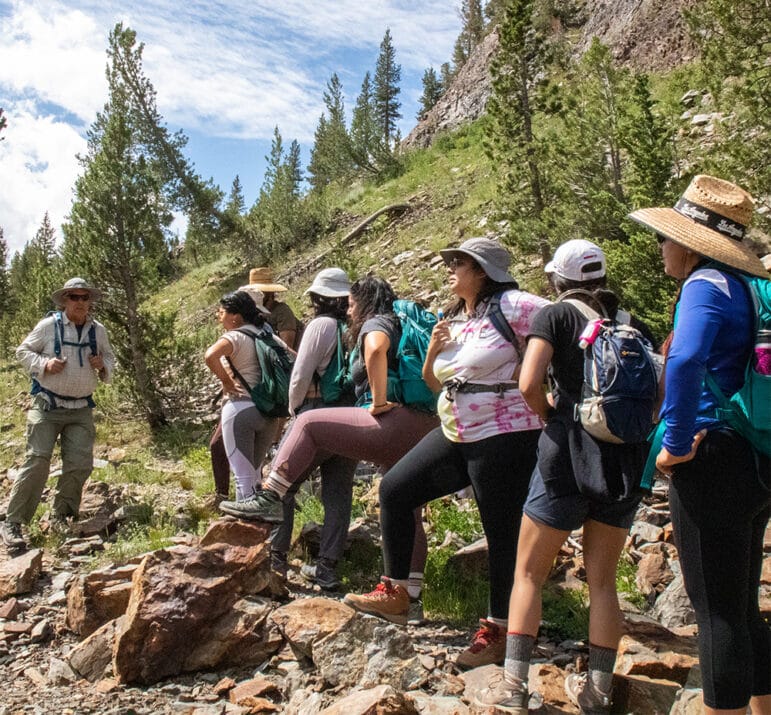
As Escruceria teaches it, the displacement and continued oppression of Indigenous people in the Eastern Sierra is a key part of this region’s story of environmental racism. That story began at the start of the 1800s when white settlers first arrived in the region. “The most critical part was the displacement of the local Natives that live here, called the Kootzaduka’a Tribe. With the mines, there were massive waves of humans moving through this area, but they needed to be fed,” he explained to the EYCEJ group. “White people with the skills of agriculture showed up here, and they had the tools to kick the Natives out of their land, and turn that land to be used for agriculture and animals. They transformed the creeks, diverted water, irrigated what was once upon a time a beautiful sagebrush country, and then they turned around and hired the local Natives to work for them. Have you guys heard of irony? You are the owner of the land one day, the very next day you’re working for some person that doesn’t belong in your land so that you can make a living to sustain your families. That’s what happened here.”
In the modern day, the racism that persists from this theft of land is still clear. It shapes the power dynamics of the Eastern Sierra, where white people make up less than half of the population in many towns, but hold a disproportionate amount of wealth, capital, and political power—on land that never belonged to us in the first place. The interaction with Inyo County police left George Barlow, a local Native man, in the hospital on life support, is just one example of the continued oppression and violence aimed at Indigenous people in this area.
Providing OEC participants with knowledge like this, Escruceria said, opens many people’s minds. “I really don’t call it teaching as much as opening little doors and letting them stick their heads in and see, okay, this is what’s going on here,” he said. “I am a facilitator of doors, that’s my job title. I just make it easy for them to open the doors to peek in and see the different aspects of their lives in California, in this case through water as the medium.”
The “door” into knowledge about the history of water in the Mono Basin and the Eastern Sierra reveals that the water flowing to Los Angeles was acquired through bloody and unjust means—taken from stolen land. It then goes on to sustain a city whose access to and use of that water is similarly discriminatory and unbalanced. “Our water is being stolen, and it’s not even being respected. The companies that are handling it here locally, are not treating it as if it is sacred, as if it is alive, because they don’t view it in that way,” said Dela Cruz. “Then we get it, and it’s dirty, it’s disgusting, it’s brown, it’s smelly. That’s what I grew up with. We couldn’t even wash our clothing sometimes, because then it would become brown or yellow. We never cooked with that water.” The act of physically being in the area from which this water originates gives this connection between injustices even more magnitude, Dela Cruz said. “It’s one thing to be told and to learn that your water is stolen from these areas, but I think it’s an even deeper feeling to see it with your own eyes, to look and to hear it,” she said. Sanchez added: “We were literally wading in it. Do you remember? We rolled up our pant legs, and we walked in that water. We experienced it fully.”
Looking back through history, group members explained, these modern day injustices are connected in the fact that they originate from the very same root—colonization of the Americas. “[Colonization] did exactly what it was supposed to do, which was to have this lasting effect on folks and their connection with nature, with religion, with politics, with everything,” said Sanchez. “The system that they built was able to do so much damage, for so long.” The white supremacy inherently tied to colonization is another root cause, Dela Cruz said. “We talked about Black Lives Matter and what it looks like in LA, and what it looks like in Lee Vining. In both spaces, we can continue to push for conversations where we ask critical questions of ourselves and the spaces we are in, and how we navigate our neighborhoods,” she said. “Ultimately, we need to ask how we can break from that false idea of white people and white supremacy, the idea that white people are better than anyone.”
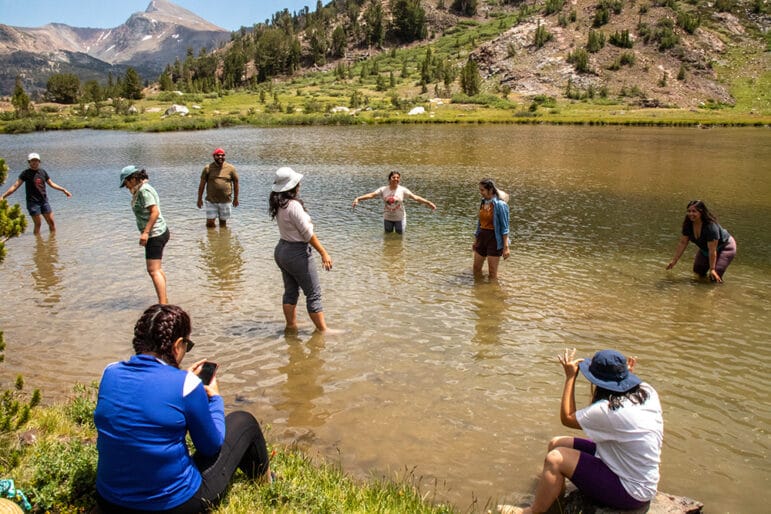
Ceja spoke on what she learned about the history of Indigenous people and present day racism in the Eastern Sierra. “It saddens me too, because you see this as such a beautiful place, but once you dig in, you’ll see that there’s a lot of problems with it as well,” she said. “We want better for our community, so I want better for you guys as well. We are fighting for environmental justice in our communities, so I would want the same for everybody, in their communities as well. Mono Lake’s level is too low, and that doesn’t sit right with me.”
With this understanding of root causes and the web of injustices they have produced, came inspiration to resist them. That is the very work that EYCEJ and Pacoima Beautiful are founded in, and fighting for. And for some group members, learning about environmental injustices in the Eastern Sierra, and Los Angeles’ implications in them, broadened their definition of what it will mean to fight for justice in their communities. “Before, my definition of environmental justice was city-based, concerning air pollution, and the disproportionate placings of environmental burdens. But it’s even broader than that, and this trip really opened my eyes to that,” said Diaz. “What we do in LA has impacts across our boundaries, across hundreds of miles of land. It definitely opened my eyes, and going back … I feel energized and ready to have this new mindset of ‘there’s this whole world out there.’ I’m not defined by the city anymore.”
Perhaps, then, injustices aren’t the only things that are connected. The drive to resist, and the tools we need to fight for a more just world, are bound together just as closely. “The word that really stands out to me from that experience is ‘connectedness,’ said Dela Cruz. “From us looking up at the stars and understanding who we are in the context of what we call Los Angeles, what we call California, until you get to the universe, to then understanding our relationship with the birds that are migrating through that area, to the water, to the land, to each other. This experience just helped me gain a better sense of how connected we are. And to see quite literally how that happens—from soil that gets moved by the wind to another area, and how necessary that is, or fish and the food that they eat, there’s a cycle to it all.”
Moreno spoke about the hope that the story of Mono Lake has provided her with. Despite the rocky history of water ownership in the area, people who cared for the land were successful in winning the legal battle to keep Mono Lake healthy, and are still fighting to protect it today. “Now [the students] have seen this story and they can see that this lake was saved. It’s teaching them that when they go back, if there’s an issue in their community, it’s possible. You can’t say victories haven’t been won, because Mono Lake was an example of that,” she said.
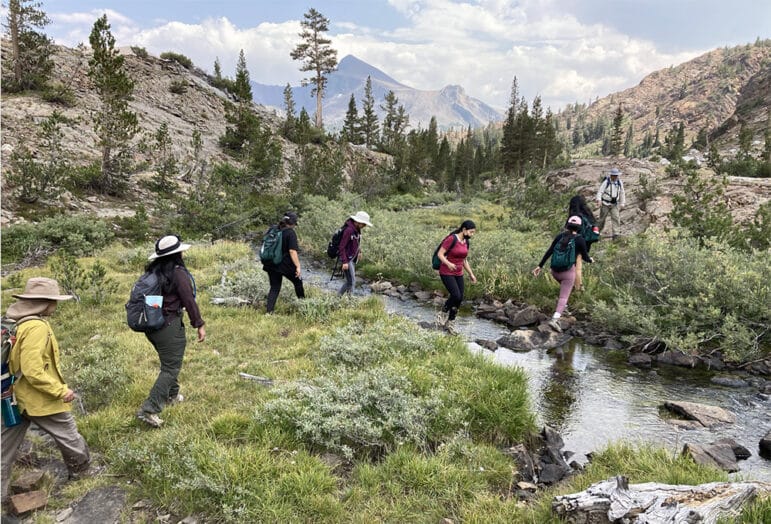
As OEC tradition goes, on the last night of the trip, the group gathers together for their closing circle. Every closing circle, participants are asked to share what they liked about their experience, what they learned, what they will take home with them, and a thanks they have to offer. Escruceria takes out the talking stone, which several thousand students have held over the years of this program. We pass it between ourselves as we take turns talking. When you are holding the stone, nobody else can talk. As we moved around the circle, the room filled with that thick, rich type of silence that indicates listening, listening in an authentic and real way. What people share in this room is personal and real and poignant and it’s the type of environment where you feel like you can share anything, or start crying, and no judgment will be held, only support.
When we finish going around the circle, Escruceria gives his closing advice. He told Pacoima Beautiful that the Mono Lake Committee used two things to save Mono Lake: their brains, and their hearts. They had common sense and science on their side, but they also used their passion, their care, and their deep love for this place in order to preserve it. Santiago advises us in the circle that we should apply this example to many different aspects of our lives—if you have the common sense but not the deep care, it isn’t worth it. “I’m in love with this place. That’s why I love what I do,” he said.
It seemed that those words stuck with everyone. “I thought that my perspective couldn’t be changed, because I’m already an advocate,” Ceja reflected. “But going up to Mono Lake, it changes your perspective a lot. Sometimes you lose hope. I’ve lost hope before. But places like these, they motivate you again. And if I don’t stand up for them, who’s going to?”
Top photo courtesy of Vianey Moreno, Pacoima Beautiful.
